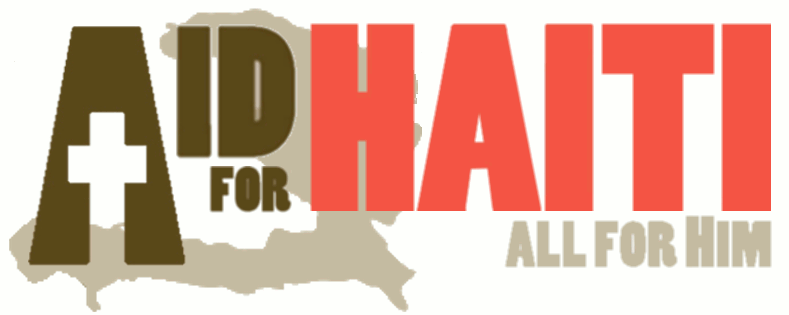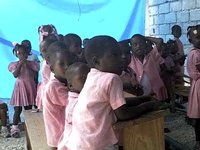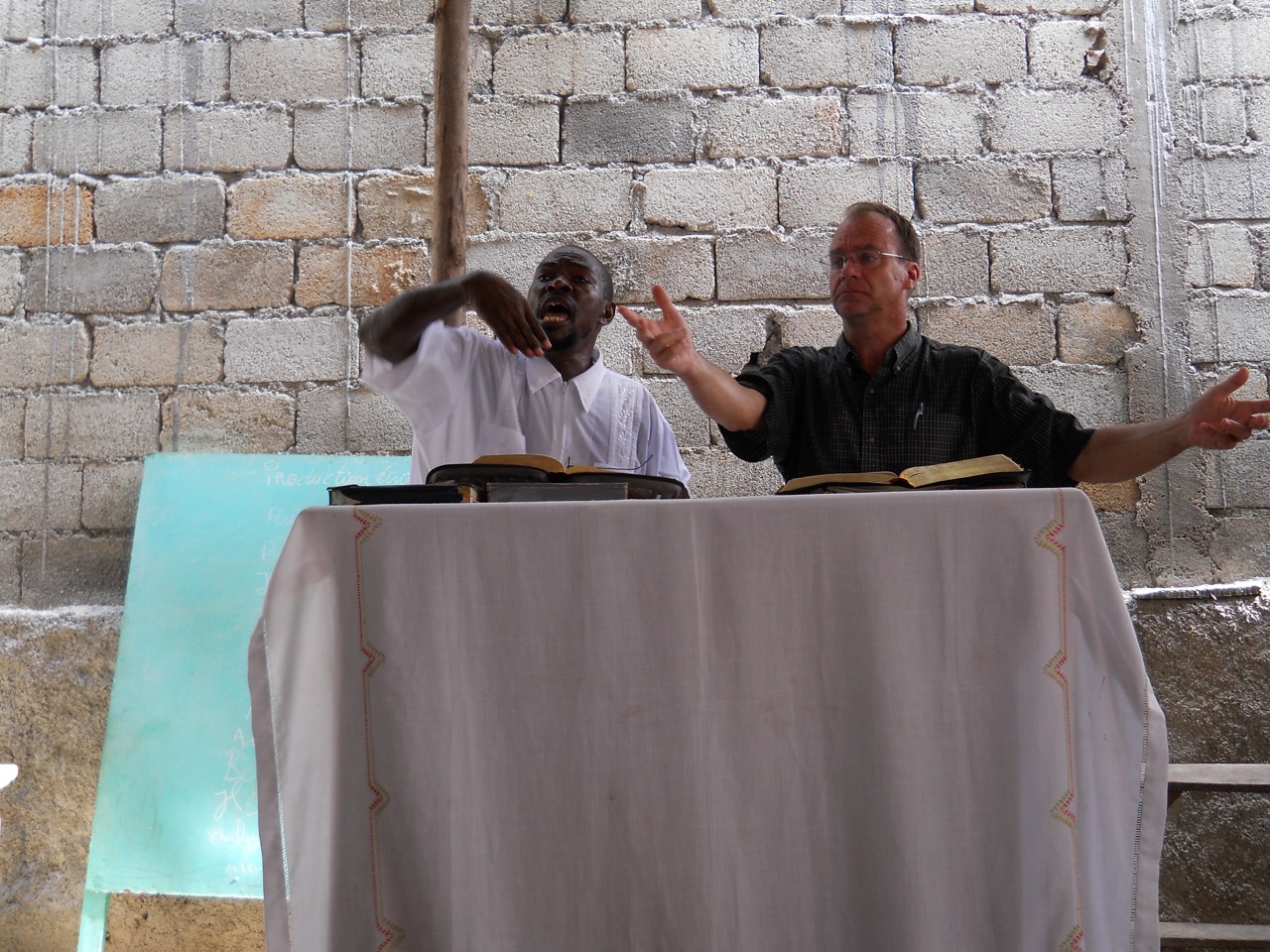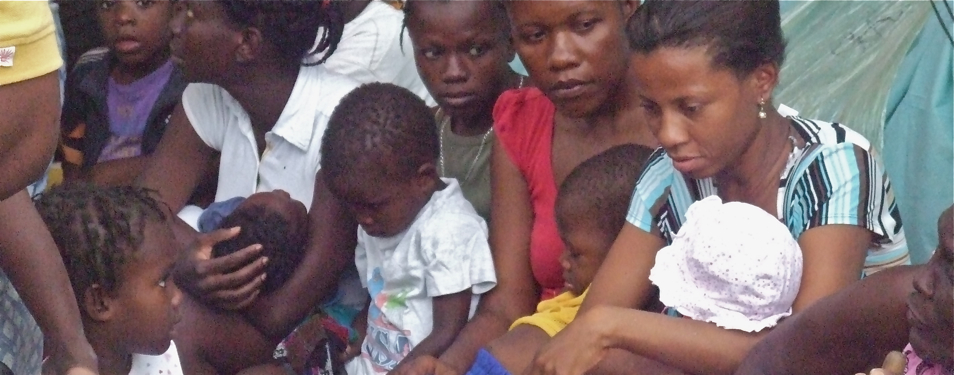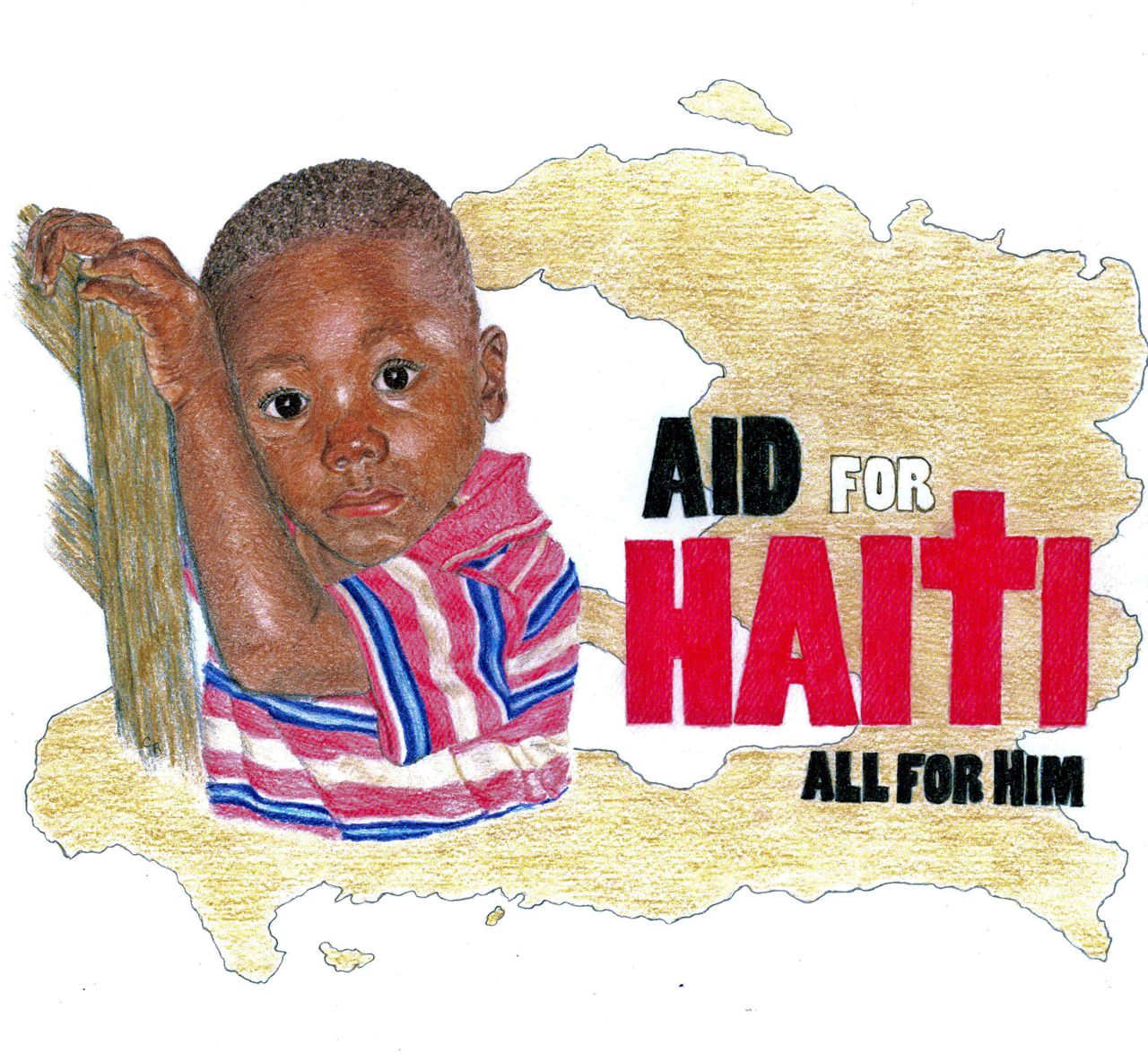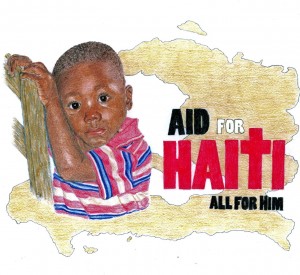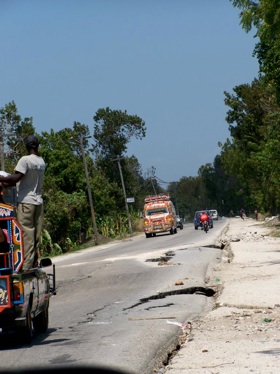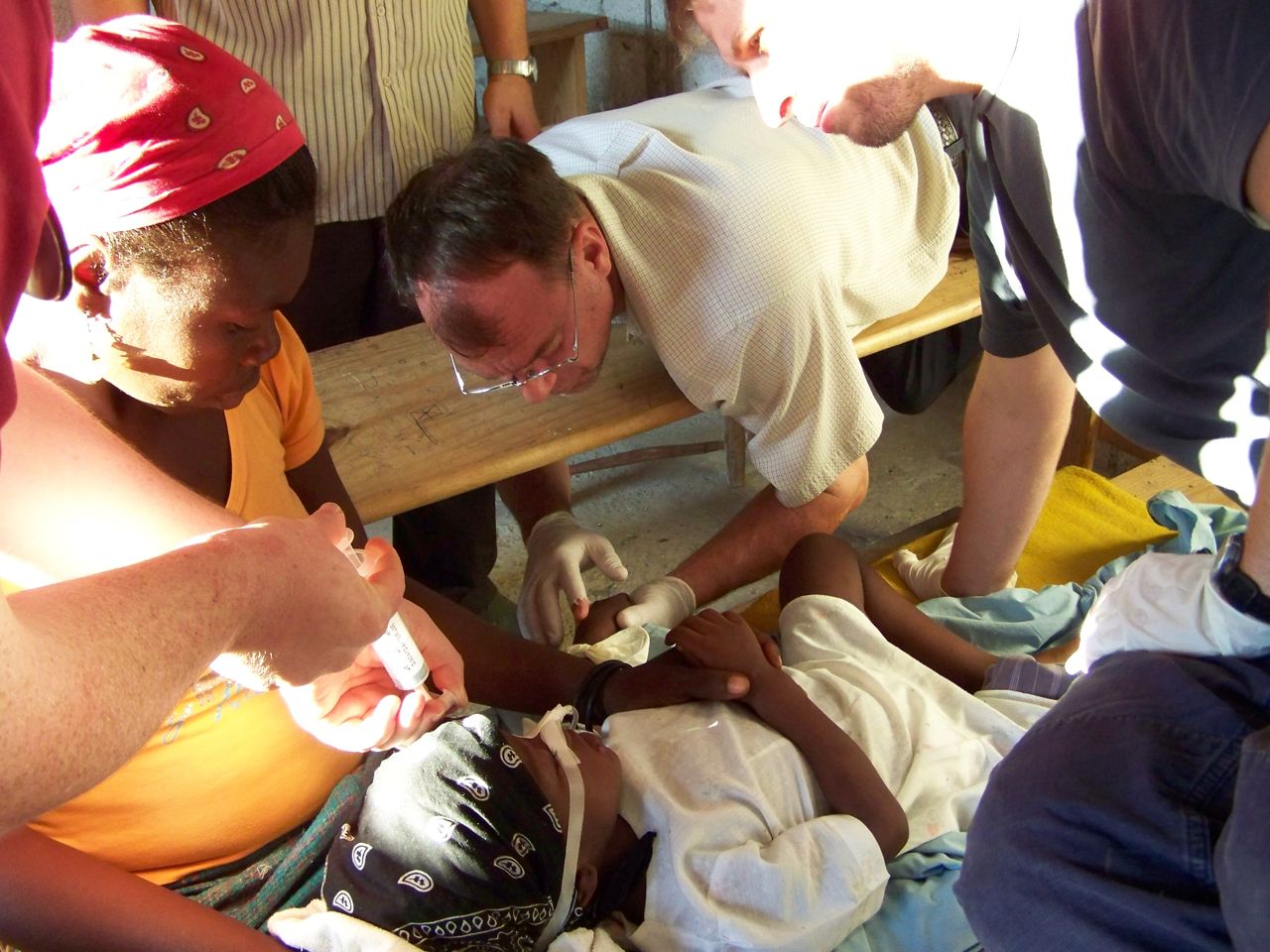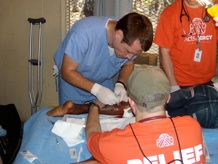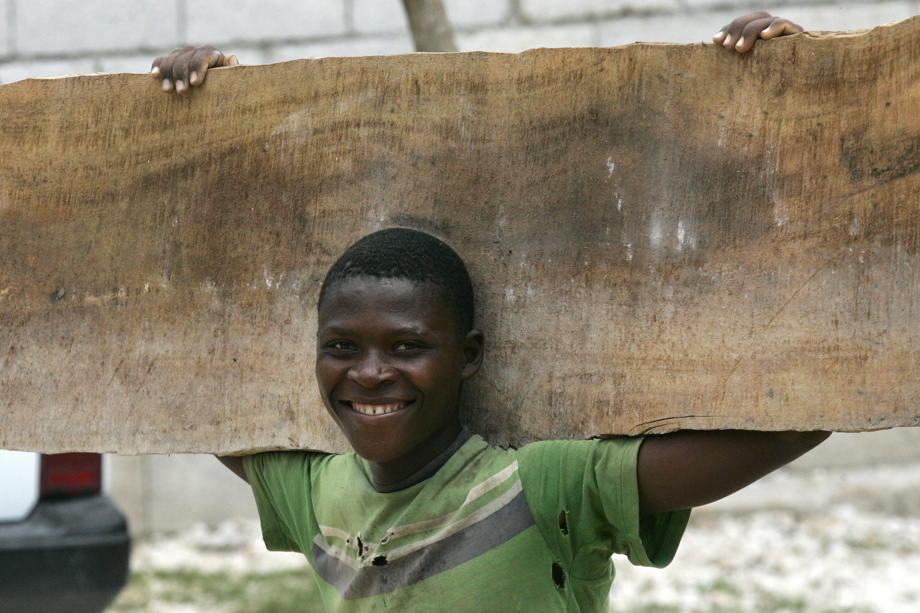Pastor Training and a Water Project
Pastor training in the town of Fon Doux. We also coordinated the building of a well and water treatment operation in the city of Lacule, Haiti.
[nggallery id=11]
2010, so far
As the 6 month post earthquake point passed we want to keep you, our ministry partners updated on what has happened and what is currently happening through the ministry of AFH. Immediately after the earthquake we provided oversight and staffing for the field hospital in the Petit Goave area, forty miles west of Port Au Prince. Thanks to your partnership we treated about 18,000 patients, delivered 160 babies and did many minor surgeries mostly under tents. We have now returned to our more “regular” work of remote medical clinics in the more needy mountainous regions.

Our plan of operation is going into areas recommended by Haitian pastors that we have known for several years where they have outreach ministry themselves. We carry our supplies by donkey and foot into the area and setup a clinic in the buildings they use for meetings and schools. In the evenings we have gospel meetings that are open to the public. These clinics open the doors with local pastors and elders for future in-depth Bible Schools for the local leaders. Training and teaching believers that can in turn teach their own people is our goal. Medicine, community health training, and nutritional supplement programs are used to open doors and build relationships that can be developed into Bible schools and pastor/elder training. The last few years have greatly increased our burden for solid, long term Bible teaching in Haiti. We have found very little being done that is really reaching the poorer local churches and their leaders outside the larger cities. The requests for teaching and training church leaders is repeated to me again and again. Recently a training session was planned with 100 men enrolled and 300 showed up. We provide the food and teaching materials for the attendees and they provide their own travel expense if possible. The cost to us is about $10.00 U.S. per day per attendee. Our goal is to repeat the training annually in each location.
Please pray for us that the church be taught and that Christ be glorified in our labors. We have also been able to send a permanent representative, Michael Rudolph, to Petit Goave to oversee the planning for the ongoing medical and teaching teams. Michael has also been involved as he has time in aiding construction teams for other organizations working in rebuilding. He lives in one room in the clinic building that we have been renting for the last 3 months. We are praying about a more permanent base nearby.
The next few months include teaching and preaching teams in August, November, and December led by myself as well as medical outreach teams in September, October and December. Please pray for wisdom, safety and more open doors. Thank you for your interest in the work in Haiti.
Artwork
What Shall I Say
What shall I say? What words can describe the growth of a soul, what mind can find adequate expression for infinite power and might? During the time I was in Haiti in March, we saw many people in the clinic and many new lives were brought into the world, but the most significant things were the outright miracles God did! I will try to relate a few of them; try to share with you some of the awesomeness and power of our God.
A girl was brought in by her family, but her problem was spiritual, not physical. This girl definitely was under the power of an evil spirit, and several of our team members started praying for her to be delivered from it. I had never seen anyone who was possessed, much less freed from the power of an evil spirit, so I was a little skeptical about “casting out the devil” though I do believe that people can be possessed by an evil spirit. But I did not doubt the power of God to free this girl, so I decided I would stay and pray that God would do what He alone can do. We prayed and prayed for hours, and the struggle in the girl was fierce. The pastors from her church came and joined us in prayer. Finally, something happened in the girl, and the power of God triumphed once again over the devil! It was amazing! I could see a change the girl’s face, and when she was told what had gone on, she broke out crying. The work of God did not stop there; when the gospel was presented to her, she gave her life to Christ! One our translators saw the power of God and gave his life to Christ as well! My own faith was increased and strengthened, and God filled my heart with joy! What an amazing God we serve!


“Baby Caleb”
God did a few miracles in my own life. The second day we were there, Timothy’s, Jonathan’s, and my luggage was stolen. Thankfully they left our passports! We talked to the people on the compound, and over the next two days our clothes were returned but my Bible and journal were not with them. The miracle was the fact that God gave me peace about the whole situation. I kept praying and praying that He would give them back to me, but nothing happened. The morning we had to leave, I looked around the clinic and was a little disappointed that neither of them had showed up. I thought “Oh well, I’ll just have to go home with out them.” We had to leave for the airport at 11:00 am, and thirty minutes before we left I walked into the clinic. There lying in the open was my Bible! I was so surprised and overjoyed! I have no idea who bought it back; as far as I’m concerned it came straight from God Himself! My journal never did show up, but through it all I’ve learned that He truly is enough for me. I don’t need “stuff” to live. I only need a willing heart to serve Him and to bring glory to His name. I do believe though that at anytime, anywhere, He could give it back to me, even twenty years down the road!
We serve an amazing and powerful God, and I ask that you pray with me that His light and gospel will spread throughout the land of Haiti!


Report from Haiti
Report from Haiti:
Having been to Haiti previously I was not quite sure what to expect post- earthquake. The first change I noticed was when I arrived in the Nashville, International Airport. There was an aid group checking in that had a “mountain” of totes that were on their way to Port-Au-Prince. The entire trip down I met people along the way that were bound for Haiti. It was encouraging to see other NGOs putting so much into the relief efforts. Once I arrived, it was interesting to see who was really getting the work done. Not to fault the efforts of large organizations, but many of them seem to have gotten hung up in “red tape”, and many of them were stuck in the immediate area around the capitol. Upon arriving at the PAP airport we were shuttled from the plane to a large new warehouse structure where we picked up our baggage and worked our way through customs. Outside we found the driver that was to take us to Petit Goave, where we would be working on the Wesleyan Compound at our clinic. After fighting the traffic and the heat in Port-Au-Prince we spent the next several hours driving through the countryside. Along the way we saw evidence of the devastation. At one place there were the ruins of a four story building, now flattened like a stack of pancakes to a height of less than six feet. All along the way, the road was unexpectedly broken by cracks and fissures. The area of Petit Goave where our clinic was set up is nearby the ocean. That whole section of the town had shifted in the quake and dropped several feet. Every street going into the area had several places where they had to dump dirt to form a ramp to smooth out the drop off. The Wesleyan Compound was beautiful with its location by the ocean facilitating a cool breeze off the water. The building that we were using for our clinic was mainly being used for a pharmacy, with one end set up for OB and neonatal care. Surrounding the clinic building was an assortment of canopies, tarps and benches where we treated patients. We also had one wooden outbuilding that The U.S. Marines built us, which we were using as an ICU for patients that needed more than walk-in and walk-out care. After we dropped our luggage in the various tents where we were to sleep, we quickly got started helping with the patient load. The first several days passed with a flurry of activity.

Emergencies and mothers coming in to deliver their babies continued 24 hours a day. The first evening there we devised a plan of primary and secondary OB and trauma teams to manage through the nights that would allow for those who were already there to get some much needed rest. Being an EMT-IV, I was assigned to Trauma team 1. The first night we spent most of the night taking care of various injuries that came in. Over the next several nights we had motor vehicle accident injuries, a gunshot wound (the result of a “cited” intervention by the police in a robbery???), a security guard who was assaulted with a machete, and various other trauma cases. Following the earthquake our clinic was providing the only medical care to the area. The Notre Dame hospital in Petit Goave had stopped operations for a number of weeks due to staffing problems and other issues. One of the goals for our time there was to gradually shift the medical care back over to the hospital without overwhelming them with a sudden transfer of all fields of patient care. One area of care that we were providing was OB and delivery. Several nights we had 2 or 3 mothers walking the compound between contractions, waiting for imminent delivery. There were so many deliveries that everyone got to assist in as many as they cared to and there were still plenty more to deliver. We had many patients for whom we provided the best care we had available and prayed for them, trusting the healing power of God. There were several cases in which it was very obvious that it was the healing hand of God that made them well. One of those cases was a young girl that presented with cerebral malaria. She came in already in the coma stage of the disease. At this point it is very critical to get IV treatment started immediately. We were able to get an IV started and started the medication. The problem was that we were not sure if she had been brought to us soon enough for the treatment to take effect before it was too late. We spent hours praying over her and finally she became responsive and definitely took a turn for the better. We cared for her through the night and the next morning she was well enough to go home. Even though we spent many nights with very little sleep, God gave us the strength to continue in our efforts and we were able to help many people. By the end of our time there we had accomplished a complete shift of all aspects of the local medical care except OB and some of the nighttime emergencies.

These were to continue to be phased out over the next several weeks until the hospital was able to handle everything. We were blessed by many volunteers that worked alongside us in our efforts, and also with monetary support that was and still is a vital need to our continued ministry. Also as we were shifting the care back to the local hospital, we were preparing to move to a new location several kilometers away in the small town of La’Cule. We spent hours sorting through our supplies, packing them in boxes, and trucking them to the new location. Our work continues there as we provide medical care to that location and also use it as a base for our mobile clinic. We continue to make trips into the mountains, taking along our buckets filled with meds and hiking, sometimes several hours, to reach the remote villages. We treasure each of your prayers and other support in any way God lays it on your heart to help. We recognize that even our best efforts without the blessing of God and the support of His people would amount to very little. Please continue to pray for the work in Haiti, that God would continue to give us guidance in directing us to the areas where we are most needed. Also that God would continue to work in the hearts of the people as we share the good news of the Gospel, that souls would be saved and that the power of Satan would be vanquished across the country of Haiti.
Ministry Update
Continuing to travel to remote areas of Haiti to minister to ever increasing numbers of people has defined the ministry of Aid for Haiti since the earthquake relief began. Since moving from the wesleyan center we have been able to maintain long term staff within Haiti which has opened up our ministry greatly. We now operate a long term base clinic near Petit Goave, Haiti. Here, the Maranatha Clinic has given us the opportunity help heal thousands of patients and share Christ with many. In addition to this, as you can see on the map, there have been numerous opportunities to continue the remote medical work. Throughout Haiti, from the mountainous town of Potino, to the costal villages of Trou Choo Choo, the opportunities to heal the lives of people and share the life changing message of Christ have never been larger.
We now have new opportunities in many different ministries. Plans are going forward now to put on two new pastor training conferences in both the southern town of Fon Doux and the mountainous village of Potino. Many pastors are in dire need of any training they can obtain. As was stated to us on a recent trip for a pastor “I am like a baker with no flour, I have so many looking to me for instruction, but I have little myself.” Teaching critical ideas about christianity, such as how to study the bible, will make a huge impact on the rural pastors and their churches throughout the land. Bibles are both expensive and in short supply in Haiti’s native tongue, creole. We have been blessed with a donation of 5,000 creole bibles and have begun to ship them to Haiti to be distributed to pastors during these conferences.
This description just begins to scratch the surface of the blessing that God is pouring out on the people of Haiti through your faithful gifts. We thank you for your love, prayer and financial support. This work would not be able to continue without you loving partnership.
The History of AFH and the Earthquake
The History of AFH and the Earthquake
Sarah Tenpenny
In 2006, a University of Tennessee medical student received a letter from a friend telling him of many Haitians living in the mountains with large growths on their necks. Interested in the condition and helping the Haitian people, he teamed up with two fellow students forming what was the very beginning of Aid for Haiti. After further investigation and research, AFH discovered the Haitian people were victims of iodine deficiency. The lack of a simple element that you and I find in our table salt causes devastating mental retardation in the Haitian children and large goiters in the adults. As we began treatment for this condition, we quickly realized that most of the Haitians in this area have little to no access to health care. Our hearts were broken, and we responded. Over the last 2 years, we have provided medical clinics in the rural mountains of southern Haiti, as well as, spiritual training for the local pastors. This training is often the first they have ever received. One pastor stated, “I am like a baker with no flour. I have church with people that look to me for instruction, but I have little myself.” We have slept in their houses, eaten at their tables, shared our hearts and love for Christ, and developed lasting relationships. And thus, we find our lives intertwined with the people of Haiti.
January 12, 2010, a 7.0 earthquake hits Port-au-Prince, Haiti. It’s late afternoon. Schools are finishing up, and people are getting off work. When suddenly, the earth begins to rumble. Buildings collapse. Power goes out. Thousands are dead. Others are screaming. And then, the sun goes down…I can’t imagine the hell the Haitian people experienced that night. In a single moment, their whole world was changed by a rare and unrecognizable event, as Haiti has not experienced an earthquake in over 200 years. After several days, we are able to make contact with our friends. All are alive; however, the impact of this disaster is taking its toll. Each day, we hear the growing fatigue in their voices as they work to gather, feed, and care for the survivors. After expending their own resources, our friends plead to us for help. They are exhausted, hungry, and in dire need of medicine.
Within 2 weeks of the earthquake, an AFH team is in Port-au-Prince. We are able to set up a makeshift clinic and distribute medical care, food, and water to our dear friends in PAP and Carrefour. A few days later, AFH moves on to Petit Goave, a town located near the epicenter of the earthquake. We begin to convert a ministry compound into a field hospital. Since the city hospital has been deemed unsafe, we assume responsibility of all care for the entire city. Overnight, Dr. Caleb serves as the only general doctor for a city of 150,000. “We are on our 5th delivery of the night; one person showed up dying of a simple asthma attack; and there seems to be a never ending line of new trauma sustained during the earthquake.” After only two hours of sleep, Dr. Caleb states, “God has blessed us though. It seems that every time we turn around, there is a new critical patient with a problem out of our scope, but we seem to have just the right medicine at just the right time. You can tell God is doing a wonderful thing here.” Even when overwhelmed, God has provided a way. Over the past two months, AFH has provided continuous medical care to the area of Petit Goave. We would never have been able to do this without the help of the Wesleyan Mission, multiple volunteer physicians, nurses, and EMTs, the Haitian nurses, Samaritan’s Purse, the American and Spanish Marines, as well as, you and your continued prayer and financial support. As the local hospital gets back running, AFH will begin its transition back to serving the people in rural Haiti. God has definitely opened many doors for AFH and we’re excited to see where He is leading and how we will be able to minister and share His love in the future.
The Village of Potino
Ministry continued at the Maranatha clinic in Lacule and in Potino.
[nggallery id=9]
Show Me Where To Put the Sugar
CMDA
Tuesday, March 9, 2010
The Haitian nurse in the wound clinic said to me, “Show me where to put the sugar”.
I was helping provide emergency medical care in a coastal town 42 miles southwest of Port-au-Prince. The temporary emergency “hospital” was located on the Wesleyan Church Compound in Petit Goave. Since the earthquake, the town’s population had swelled to over 100,000 from its usual 15,000. The town’s small hospital had not been functioning since the earthquake in January and this temporary “emergency facility”, a conglomeration of tarps and tents, was serving hundreds every day.
The wound clinic was under a white tarp large enough to shade several benches where people waited. Three sheets of plywood on crude legs became the treatment areas. The word seemed to spread quickly that wound care was available and people just kept coming. It had been more than a month since the earthquake, but many wounds had had little to no proper attention.
Each wound represented someone who was wounded much deeper that the wound itself and I was impressed as I watched the Haitian nurses lovingly care for each one. Bacteria were having their way in many of the wounds which caused infection and destruction of tissues. Betadine was the most used agent to clean and dress wounds – some improving while many were not. My mind went to Kenya when in the late 90’s we began revisiting the use of sugar and honey for deeply infected wounds. We found it to be very effective in stimulating healing in chronic septic wounds. Several articles were appearing in medical journals around the time, including journals of wound care, encouraging the use of honey or sugar if honey was not available. This was not new; it had been used for over 4000 years – with great success. But, in favor of more expensive and “up-to-date” methods, its use had greatly diminished.
Now, here I was in Haiti; a land where sugar production and growing of sugar care by peasant farmers has been part of a troubled nation. In my hand was a cup of strong Haitian coffee to which I had added 2 tablespoons of sugar. But, I did not see any sugar on the wound dressing table. There was only betadine and that was not in great supply. One of the problems with betadine is that it causes necrosis of good tissue as well as infected tissues. The necrosis of good tissue promotes ongoing infection and poor or delayed wound healing along with increased pain in comparison to honey or sugar. I asked one of the nurses if they ever used honey or sugar in the wounds. The incredulous stares answered my question. In fact they seemed to say, “You must be crazy. Don’t try to make us use something that you would not use yourself. We may be a poor country but we deserve to have care like you expect. We do not appreciate you trying to do this to us!”
I thought of all the ways the Haitian people have been taken advantage of over the last centuries. Foreign countries have plundered the once rich forests of hardwoods leaving eroded, rocky, unproductive fields and mountains. Multinational companies have paid pathetic wages to produce toys and souvenirs that bring a premium in the western world. Leadership has been unjust and has pocketed millions meant to aid those in need.
“Now, here was another rich American standing on Haitian soil for only a few days. And, he is asking if “we ever put sugar on our wounds!”?”
There were still over 200 patients waiting in line so I did not want to take extra time to extol the virtues of sugar and that it would be better. Though the nurses didn’t actually question me, I knew if they used sugar only because I wanted them to while I was watching, they were not going to do it later when I was out of the picture.
So, I knew I had to take the time to teach, to explain about the osmotic forces that keep cells from exploding or shrinking. This is the presumed mechanism of honey/sugar. It kills bacteria by osmotic forces, speeding wound healing, decreases the amount of dead tissue needing debridement, decreases pain at the time of dressing changes, and results in fewer resistant infections.
But, I sensed something more as well. Much too often in missions we from North America just want to take charge. We want to make the decisions, we want to dictate what should and will happen. Is there any wonder why the world often sees us as arrogant and conceited, even in missions? Couldn’t I just say to use sugar on these wounds? It would save a lot of time. And, after all, this is a country used to slavery and dictatorships! In my heart though I knew I could not just dictate or give a command. For far too long, decisions have been wrenched from the people. In fact, they have been told over and over again, to the point they now believe, that they are incapable of making these decisions. Yes, I could dictate this wound needed sugar and someone would apply it. But, would anyone really put their heart into it? Would sugar be used on the next patient or ever again? Would anything really change?
I had to give up the idea that I was in charge or that the decision was mine. I could only coach. I went ahead and took a few minutes to teach and to explain. I shared examples of how honey or sugar had helped in Kenya. And, I stressed how its use was on the increase in the USA and other countries. Then I encouraged the nurse to chose a few patients with dirty wounds and try the sugar.
On the table was a young boy with an infected foot – and I wanted so badly to put sugar on his wound. But, I knew it would do no good if I was the one who did. The nurses live in Haiti while I do not. They would be the ones caring for all the wounds while I would leave in a few days. It is their country, their responsibility, and their decision. I wanted to apply the sugar, but knew I should not. When I suggested, “…use it if you want and see what happens. If you are happy after several days you can decide for yourself if you want to continue. But, I will be gone and it is up to you.”, there was animated discussion that followed.
Soon someone appeared with a coffee-cup like the one in my hand. It held Haitian sugar. One of the nurses said, “Show me where to put the sugar.”!
Over the next few days, as we developed a trusting relationship, an increased number of questions came from the wound clinic. “Would you look at this wound? Could you prescribe some antibiotic and some pain medicine for this patient? Would you please drain this abscess?”
I kept looking for the sugar. Would it appear? Would it be used? I wish I could report to you that I saw hundreds of wounds now being treated with sugar. I wish I could say … No, I cannot.
But, there is sugar in Haiti. I know…I drank of it in my morning coffee. I watched as it was applied to one wound. My impatience told me to apply sugar myself everywhere, anywhere it was needed. I waited…
The Good News must be like this. Missions must be like this. What we want to give, and even impose on others, will do no good unless the heart makes the decision as one’s own. It has taken me 53 years to learn something about this and yet I still want to just have people do it my way or believe as I do.
Great good can come out of Haiti. The people are beautiful. They are fully capable of managing their lives, making decisions, bringing about change that can lead to restored relationships, productive land and a brighter future. Will we give them permission to do so? Will we communicate that we believe in them and support their decisions? Will we allow them to discover the joy of the Kingdom of God that He wants for the Haitian people?
Change takes patience over time.
I left Petit Goave last week. The last evening, as I was helping clean up from the day’s work, I noticed something. Sitting on a table – a table under the white tarp in the wound clinic, a clinic under a large mango tree – was a small coffee cup. It was not mine. The spoon in it was not mine. The sugar inside the cup was not mine. But, there it was.
There is sugar in Haiti.
“Show me where to put the sugar!”
